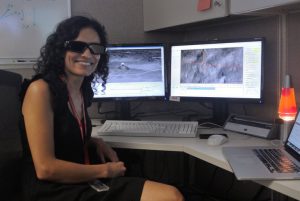
Perseverance rover, a new six-wheeled robot by NASA on Mars is starting a journey across a crater floor looking for signs of ancient life. The rover team is concerned with navigation routes, beaming up of drafting instructions and use of special 3D glasses to map their course.
As time passes, the rover will control the drive itself making use of an auto-navigation system referred to as ‘AutoNav’. This advanced system creates 3D maps of the terrain lying ahead, detects hazards and plans a route devoid of obstacles without further assistance from controllers on Earth.
‘We have a capability called “thinking while driving”’, said Vandi Verma, Senior Engineer, Rover Planner and Driver at NASA’s Jet Propulsion Laboratory in Southern California. ‘The rover is thinking about the autonomous drive while its wheels are turning.’
This ability along with other enhancements may allow Perseverance attain a top speed of 120 meters per hour. Its predecessor ‘Curiosity’ could only hit 20 meters per hour while climbing Mount Sharp to the southeast.
‘We sped up AutoNav by four or five times’, said Michael McHenry, Mobility Domain Lead and part of JPL’s team of rover planners. ‘We’re driving a lot farther in a lot less time than Curiosity demonstrated.’
AutoNav will be a key feature in helping Perseverance start its first science campaign on Jezero Crater, which was once a lake. Perseverance’s destination is a thawed-out river delta at the edge of the crater. If there is life on Mars, signs of it may be discovered there. The rover will collect samples over 15 kilometers and prepare them for retrieval by a future mission to take back to Earth for analysis.
‘We’re going to be able to get to places the scientists want to go much more quickly,’ said Jennifer Trosper, a worker on NASA’s Martian rovers and the current Mars 2020 Perseverance rover project manager. ‘Now, we are able to drive through these more complex terrains instead of going around them: It’s not something we’ve been able to do before.’
Nevertheless, the involvement of the rover team is very critical in the planning and driving of Perseverance’s route. A team of specialists develops the navigation route and plans the activities of the rover, if its task will be to examine a geologically fascinating feature or taking samples.
As a result of the radio signal delay between Mars and Earth, the rover cannot simply be moved with a joystick. Satellite images are scrutinized using special 3D glasses to examine the Martian surface in the rover’s vicinity. Once the team signs off, the instructions are beamed to Mars and the rover executes them the next day.
Perseverance’s wheels were designed to help with the swiftness of the executions of the plans. It is greater in diameter and narrower than Curiosity’s wheels. They each have 48 treads which resemble wavy lines. Their goal is to help with durability and traction.
‘Curiosity couldn’t AutoNav because of the wheel-wear issue,’ said Trosper. ‘Early in the mission, we experienced small, sharp, pointy rocks starting to put holes in the wheels, and our AutoNav didn’t avoid those.’
Perseverance’s belly was also modified for higher clearance to enable the rover roll safely over rough terrain. Perseverance’s enhanced auto-navigation abilities include ENav (Enhanced Navigation), an algorithm/software allowing more precise hazard detection.
Dissimilar to its predecessors, Perseverance can use one of its computers only for navigation on the surface. Its main computer can focus on other tasks to keep the rover healthy and active.
The Vision Compute Element (VCE) guided Perseverance to the Martian surface during its entry, descent and landing. It is currently being used full-time to plan the rover’s journey and assist it avoid hindrances on the way.
The rover keeps track of its distance from one spot to another using a system called ‘visual odometry’. It regularly captures images as it moves, likening one position to the next to observe if it moved the expected distance.
Team members are looking forward to seeing AutoNav ‘take the wheel’, being ready to intervene where necessary.
‘Jezero is incredible’, Verma said. ‘It’s a rover driver’s paradise. When you put on the 3D glasses, you see so much more undulation in the terrain. Some days, I just stare at the images.’
By Marvellous Iwendi.
Source: JPL